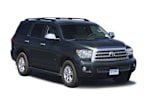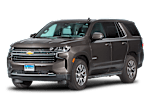Toyota's largest SUV was redesigned in 2008, again based on the Tundra pickup truck. Unlike the first generation Sequoia, this second generation goes toe to toe with other large SUV competitors when it comes to interior space and towing capacity. Spacious seating for eight is a highlight, with one of the few third-row seats that can comfortably fit three adults across. Potent power comes from the top engine choice, a 5.7-liter V8 that supplies brisk acceleration. At 15 mpg overall, fuel economy is respectable for its class, but still isn't great. Smaller and refined V8s are also available. Handling is clumsy and even though the ride was improved, it still feels like a truck to drive. Off-road capability is impressive. Controls are simple to use, but it's a long reach to some of the radio controls across the wide cabin.
A long-overdue 2016 update brought more modern infotainment and available blind spot monitoring. Overall though, the Sequoia feels dated next to more modern competition. The 2018 model gets the Toyota Safety Sense-P (TSS-P) as standard equipment on all trim lines. TSS-P includes forward collision warning with automatic braking and pedestrian detection, lane departure warning with lane keeping assist, and adaptive cruise control. Other 2018 updates include an new trim level, called called TRD Sport. Available on four- and two-wheel drive models, the added equipment includes specially tuned Bilstein shocks and beefier front and rear anti-sway bars, 20-inch wheels, LED headlights, and various "TRD" badging. All 2020 models get standard Android Auto and Apple CarPlay compatibility.







































